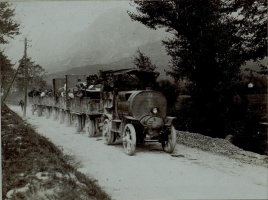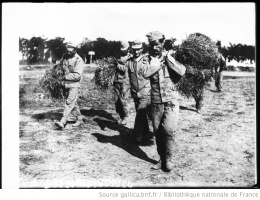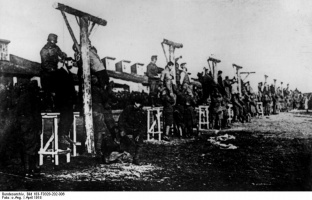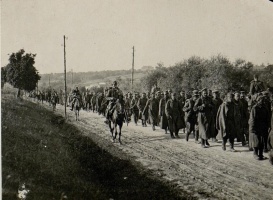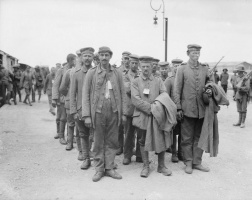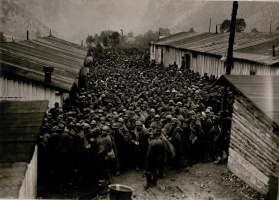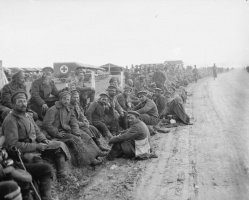Introduction↑
This article explores the experiences of prisoners of war and internees from Serbia, Montenegro and Romania in camps throughout Austria-Hungary, Bulgaria and Germany after these countries had been victorious in South East Europe in the autumn of 1915 and 1916. Civilian internees, a novel feature of the First World War, did not have a defined status under international law at the beginning of the war and only afterwards was their treatment found to constitute war crimes by the victorious Entente. Civilians and imprisoned soldiers alike were subjected to harsh living conditions, unsteady food supply, and poor medical care in the network of camps that stretched across Austria-Hungary, Germany and Bulgaria. It is difficult to determine how many inhabitants of South East Europe experienced the camps during the war though some data exists on the population and mortality rate within the camps.
The Occupation of Serbia, Montenegro and Romania 1915-1916↑
Austria-Hungary’s declaration of war on Serbia on 28 July 1914 marked the beginning of the First World War. In September 1915, a combined Austro-Hungarian and German offensive breached Serbian territory from the north and west while the Bulgarian army entered from the south-east. By early January 1916 all of Serbia was occupied by the Central Powers, its army pushed to the south through Albania to the Adriatic coast and thousands of Serbian soldiers were taken as prisoners of war. After Serbia had been conquered, a major campaign was conducted against Montenegro in January 1916 and the state quickly capitulated.[1]
Though Romania entered into the war on the side of the Entente in late August 1916, the Central Powers occupied much of Romania from autumn 1916 until December 1917. Because Romania was able to maintain an active frontline with the help of Russian forces, the Central Powers were not able to establish as entrenched in a military occupation as in Serbia or Montenegro. Therefore, the number of civilian internees from Romania was comparatively small,[2] while the number of POWs was large.[3]
After the military defeat of Serbia in the autumn of 1915, Germany, Austria-Hungary and Bulgaria divided the country into zones of control. Germany limited its occupational presence to the control of the main road and the railroad running through the valley of Velika Morava, as well as around some mines in the eastern part of Serbia. Bulgaria commanded two zones: the “Military area of Morava,” with its centre in Niš and the “Military area of Macedonia,” with its centre in Skopje. Austria-Hungary established military rule with its centre in Belgrade (K. und k. Militär-General-Gouvernements Serbien, or MGG/S) in its zone of control from 1 January until 15 March 1916.[4] Austria-Hungary also set up similar rule in Montenegro (K. und k. Militär-General-Gouvernements Montenegro, or MGG/M) on 1 March 1916.
The Status of Civilians under Occupation in South East Europe↑
At the beginning of the war, a system of formal protection for civilians under enemy control had not been yet established in international law “apart from a few vague references in articles 42 to 56 of the 1907 Hague convention (Part IV) to the rights of populations living in occupied territories.”[5] Civilian prisoners generally had fewer rights than prisoners of war under international law “and were especially vulnerable to reprisals and counter-reprisals.”[6]
The people living in the occupied zones of South East Europe were denied citizen status by the Central Powers who declared the Serbian state an invalid political entity. Both Bulgaria and Austria-Hungary publicly announced in 1916 that Serbia had been wiped off the political map of Europe. Therefore, inhabitants could not invoke international rules of war, such as those defined by the Geneva Conventions. The Bulgarian government refused to recognize the Serbian Red Cross in Geneva on these grounds.[7] Moreover, in 1916 Austria-Hungary barely respected the offers made by the International Red Cross to distribute letters and packages. To no avail the Red Cross also offered to disseminate information between Serbs abroad and those in their homeland as well as between prisoners of war and internees in the camps of Central Powers and their families. Bulgaria did not respect these offers at all.[8] These constituted violations of the Hague Conventions of 1899 and 1907 as well as the Geneva Conventions which all belligerent parties had signed[9] except for Serbia and Montenegro.[10]
The first months of occupation in Serbia were marked by purges of the educated segments of the population, including teachers, priests, and politicians. As active military officers had already been deported to camps in Bulgaria, Austria, Bohemia, and Hungary, these educated social groups were considered the principal remaining bearers of Serbian national identity and cohesion and, thus posed a threat to the occupying regimes.[11] This is why the urban population was the first to suffer internment, while peasants were persecuted and deported later in the summer of 1916 when Romania entered the war and the Allies achieved their first major success on the Macedonian Front.[12]
Records show a number of incidents in which members of the middle class and intelligentsia were killed in the Bulgarian zones of south-east Serbia. Particularly harsh treatment was aimed at the clergy: hundreds were interned in Bulgaria and circa 100 were killed, including Bishop Vićentije Krdžić (1853-1915) from Skopje. Austro-Hungarian army authorities in Serbia handed over several senior clergy members from the Serbian Orthodox Church to the Bulgarians to be interned in Bulgaria during the war.[13]
After the war, the authors of the Allied Commission on the responsibility of the war (Paris, January 1919)[14] determined that “the violations catalogued by the Commission fell within the meaning of war crimes under law and custom and the 1907 Hague Convention.”[15] In addition to those mentioned above, these violations included: putting hostages to death, torture of civilians, deportation of civilians, internment of civilians under inhuman conditions, forced labor of civilians in connection with the military operations of the enemy, usurpation of sovereignty during military occupation, attempts to denationalize the inhabitants of occupied territory, confiscation of property, imposition of collective penalties, and the breach of rules relating to the use of the Red Cross.[16]
Deportations of POWs and Internees from Serbia, Montenegro and Romania↑
The Austro-Hungarian occupying regime in Belgrade, as well as the High Command in Vienna, considered sending civilian prisoners to internment camps as a preventive rather than a punitive measure. Frequently the criteria for selecting individuals to be deported were unclear.[17] In practice, the occupying regime tried to place all able-bodied men aged seventeen to fifty-five under its immediate control, as well as those, regardless of age or sex, who were regarded as dangerous.[18]
There were four major waves of deportations in Serbia during the occupation. First, in the autumn of 1915 between 20,000 and 25,000 people were sent to the camps. These were mostly able-bodied men, ex-soldiers, politically suspicious persons, as well as members of political, cultural or sport organizations. After Romania entered the war in August 1916, 16,500 people were sent to the camps. The third wave of deportations occurred in the spring of 1917. After a Serbian uprising erupted in Montenegro, an unknown number of people charged with involvement in the uprising were sent to the camps. The final wave took place in the autumn of 1918, after the Entente and its allies broke through the Macedonian Front.[19]
Similarly, in Montenegro deportations of civilians in groups both large and small took place up until the end of the occupation in four distinct phases. The first group consisted of those Montenegrins who were in Austria-Hungary when the war broke out and who were immediately sent to camps in breach of the regulations of international law. The second group consisted of those sent to camps in January 1916 after the capitulation of the Kingdom of Montenegro. The third group were those connected with the previously mentioned unsuccessful uprising in Montenegro in June 1916 and were deported between June and August 1916. The fourth group consisted of all other deportations until May 1918. Internees were sent to camps in Austria-Hungary or were forced to labor in Bosnia as well as in occupied north-east Italy (for example, Trieste after 1917).[20]
The Austro-Hungarian military governor of Montenegro in Cetinje made a decision in June 1916 to deport men capable of bearing arms from Kolašin and Durmitor, two northern districts of Montenegro. At the same time many high ranking officers from the Montenegrin army were also deported. This action included active and retired officers, some of whom were eighty years old, as well as ex-ministers, high ranking officials of the Kingdom of Montenegro, members of parliament, politicians and influential people of all sorts. As was mentioned above, Romanian civilians were not interned to the same degree as Serbians and Montenegrins due to the active front on Romanian soil.[21]
Network of Camps in Germany, Austria-Hungary and Bulgaria↑
Camps in Germany[22] and Austria-Hungary were generally known as Kriegsgefangenenlager (prisoner of war camp). However, there were three types of camps designed to house specific detainees:[23] Mannschaftslager (Other Ranks’ Camp) for soldiers and NCOs; Offizierslager (Officer Camp) for commissioned officers; and Internierungslager (Internment Camp) for civilians of enemy states.
There were several large camps for Serbian civilian internees and POWs in Austria-Hungary. These included Aschach an der Donau, Boldogasszony, Braunau, Nagymegyer, Nézsider, Heinrichsgrün, and Czegled. The most infamous camps were Nagymegyer, Nézsider and Boldogasszony, due to their high number of inmates and fatalities as well as the subsequent collective memory about the camps.[24] According to Rudolph Archibald Reiss (1875-1929), a forensic scientist who investigated the war crimes in Serbia committed by the Austro-Hungarian army, the biggest camp (Gefangenenlager) for Serbian and Montenegrin prisoners of war and civilians was in Heinrichsgrün in Bohemia (today Jindřichovice in the Czech Republic).[25] The camp complex comprised approximately 300 barracks and, in October 1916, approximately 12,000 out of the 66,000 prisoners were Serbian. This camp also had a section reserved for Serbian children aged six and older.
Reiss also mentions a second camp near the city of Sopron in Hungary which was probably the Nézsider camp built by Serbian POWs. This camp held Serbian and Russian POWs, civilian internees from Serbia and some 3,000 internees from Bosnia (men, women and 260 children). In addition, the POW camp in Boldogasszony (Hungary) initially was filled with Serbian soldiers and civilians from the regions of Kolubara and Šumadija. The stronger and healthier male inmates were usually transferred to other camps to labor on the front or do field work. For instance, Serbian POWs from Boldogasszony were transferred to Tyrol and some 1,000 persons were sent to Bolzano to work at the front, while a group of 500 soldiers and civilians were sent to Pomerania in Germany to do agricultural work.[26]
Comparable to Austria-Hungary, the Bulgarian government established a system of at least twenty-one camps including Sofia, Sliven, Ferdinand, Haskovo, Svishtov, Stara Zagora, Orhanie, and Gorno Panicharevo after having taken thousands of Serbian POWs and smaller contingents of British, French, Italian and Greek prisoners.[27] The camps that housed the largest numbers of Serbs were in Sofia and Sliven (it is estimated that the Sliven camp had over 19,000 prisoners of various nationalities), while thousands of Romanian POWs were kept in the central and western part of Bulgaria (around the Stara Planina mountain region). Nevertheless, the majority of prisoners were housed near their work placements which were outside the camps.[28]
The Number of POWs and Internees↑
It is hard to calculate the exact number of those taken prisoner by the Central Powers in South East Europe because little contemporary data is available. Obtaining such information during the war usually was conditioned on reciprocity and the Entente was unwilling to disclose the number of their prisoners of war to the International Red Cross, medical and sanitation missions, neutral countries or other interested parties.[29] Although every country which signed the Hague Convention was obligated to provide data and information about prisoners of war in their territories, the Bulgarian government particularly ignored such demands for information until the very end of the war.[30]
Some figures do exist for the year 1917. According to official data from the Red Cross in Austria-Hungary dated 1 February 1918, at the end of 1917 there were 127,500 prisoners of war and 79,000 internees from Serbia and 206,500 in total, in Austro-Hungarian and German camps. At the same time between 32,000 and 39,000 Serbian POWs and over 37,600 Serbian civilian internees were held in Bulgarian camps.[31] Approximately 28,000 Romanian prisoners of war taken following the battle of Turtucaia in September 1916 ended up in Bulgarian captivity until June 1918; other Romanian prisoners were captured by the Germans and Austro-Hungarians during the 1916 autumn campaign and released after the signing of the peace treaty of March 1918.[32]
Further information is known about the number of Serbs in specific Austro-Hungarian camps in 1917. In May 1917, 1,210 Serbs were imprisoned in Nagymegyer, 3,024 in Boldogasszony, 9,934 in Nézsider, 1,628 in Arad, 5,861 in Heinrichsgrün, 7,733 in Braunau and 6,355 in Aschach. Altogether there were 35,746 Serbian prisoners. This number should be expanded to include the 528 individuals who were held in other camps which were not under the jurisdiction of the Ministry of War. As for the camps on Hungarian soil, in May 1917 there were 334 Serbian internees in the camp of Vaz, 1,060 in Czegled, seventy-one in Kecskemet, 1,620 in the collection camp at Gyöngyös, totaling 3,085 persons. According to these Austro-Hungarian reports, altogether 39,359 civilian internees from Serbia were held in camps in Austria-Hungary in May 1917. This number should be expanded to include 2,500 other individuals who were being held on criminal charges.[33]
The situation regarding the number of POWs from South East Europe in Germany throughout the war is much clearer, partly because of the good administrative organization in the German army, but also due to the research that has been produced on the topic.
| Country | Captured | Released | Escaped | Deceased | Cumulated mortality rate per 1,000 | Annual mortality rate per 1,000 |
| Romania | 142,326 | 2,072 | 370 | 25,622 | 180 | 101 |
| Serbia | 28,742 | 218 | 637 | 1,871 | 65 | 30 |
| Total POWs | 2,476,731 | 122,210 | 105,816 | 142,754 | 58 | 21 |
Table 1: Number of POWs in German custody, by country of origin and total number of all POWs, 1914-18[34]
In early June 1918 the Austro-Hungarian High Command (Armeeoberkommando) asked the command office of the MGG/S in Belgrade to send information about Serbian internees (Standesnachweisung der ziv. Internierten) for the following camps: Nézsider, Braunau, Heinrichsgrün, Aschach, Boldogasszony, Nagymegyer, Arad and Mauthausen. The High Command asked for numbers regarding men able to carry weapons (between seventeen and fifty years of age), those who were older than fifty and not able to carry weapons, the number of women, the number of children below fifteen years of age, and the total number of internees taken per month and camp. The command office of MGG/S delivered the requested information for nine camps, with a total of 36,845 internees and confined persons in May 1918. Of these, 29,416 were able to carry weapons (79.8 percent), 5,466 were not able to bear arms and were older than fifty (14.8 percent), 779 were women (2.1 percent) and 1,028 were children aged fifteen or below (2.8 percent). In June 1918 a total of 33,787 persons were in those nine camps, 3,000 less than a month before.[35]
While the POWs and internees from Serbia held in Austria were concentrated in a dozen large and small camps, in the Hungarian part of the Monarchy Serbs were dispersed in smaller groups among a large number of camps, prisons, military barracks, etc. and frequently moved between them. Thus, one internee was held in twenty-nine places in total throughout Hungary and two others were held in sixteen places.[36]
It is not possible to confirm the exact number of interned Montenegrins during the occupation. Up to 9 July 1916, 1.642 persons from the District of Kolašin had been sent to the camps and 115 from Nikšić district. Among the 1,811 persons sent to Boldogasszony from Montenegro were seventeen generals and 709 officers (40 percent of the total number of those deported).[37] In April 1918 a commission from the MGG/M visited four camps in Austria-Hungary and confirmed that there were 1,004 internees in Nézsider and 302 working outside the camp, 2,081 in Boldogasszony and 800 working outside the camp, 1,126 in Nagymegyer as well as 3,600 sent to work outside the camp, 168 in Karlstein and 252 in Grossau. The total number of these internees (9,333) is probably not exact.[38]
Life and Death inside the Camps↑
The early internment camps, particularly those in Serbia in 1915, often lacked proper nourishment for prisoners, transport, health care and accommodations for internees. Internees sometimes stayed for weeks in the open air while their barracks were being built. This was especially the case in the bigger camps which held both prisoners of war and internees such as Nagymegyer, Boldogasszony and Nézsider.[39] The majority of camps in Bulgaria had similarly poor living conditions. However, the camp in Plovdiv, which housed all British and most French POWs from 1916 on, was in such good condition that the Bulgarian government used it as a “propaganda camp” and “allow[ed] international observers to visit only this camp on a regular basis.”[40]
The efforts of the Serbian government which was in exile on Corfu to help its soldiers and civilians in captivity were particularly frustrated in Bulgaria because the Bulgarian government persistently refused to provide data about the number of internees, as well as about their status and location. During 1916 and 1917 the Serbian government invoked The Hague Convention from 1907 but without results. Serbia then asked Allied and neutral countries for help, requesting that Bulgaria obey both the Geneva and Hague Conventions, which it had signed, as Serbia was doing. Thanks to the Dutch consulate in Sofia, which represented the interests of Serbia in Bulgaria, the Bulgarian government finally disclosed that in May 1917 there were 187 Serbian officers and 31,000 soldiers in Bulgarian captivity.[41]
As there were many women and children in the camps, the papal nuncio in Vienna questioned the Austro-Hungarian Imperial Foreign Minister Ottokar Graf Czernin (1872-1932) in Vienna in April 1917 as to the reasons for the imprisonment of Serbian children between ten and fifteen years old, though Count Czernin’s response remains unknown.[42] The first women deported from Montenegro in the First World War were the daughters of General Radomir Vešović (1871-1938), who had been the leader of the previously mentioned Montenegro uprising of June 1916 against Austria-Hungary. At first they were deported to Boldogasszony and later to Karlstein. However, by the end of 1916, a greater number of entire families with women and children were placed in various camps, especially in Boldogasszony and Nézsider. In April 1918, 129 children from Montenegro were listed in Boldogasszony.[43] Usually the women and children were sent to the camps for reasons such as suspicious behavior, connection with already deported persons or belonging to the certain families who were considered hostile towards the Central Powers. Most of the women and children were interned in the later phase of occupation.
Internees lived in barracks with fifty to 200 prisoners per barrack. Each barrack was numbered in the same way that every POW or internee was also assigned a number.[44] Internees were poorly fed and confronted with daily violence and beatings. During the day they worked on agricultural estates or in industrial enterprises. Most of the internees from Serbia were peasants who were subsequently grouped in special working brigades of 250 to 300 individuals for labor in the fields or in factories.[45]
Everyday meals in the camps consisted of water, tea, potatoes and beets. For 1,010 internees in Boldogasszony the daily ration in 1916 was: 230 kilos of beans, 140 kilos of meat, 100 kilos of potato, ten kilos of lard, twenty-five kilos of vegetables, some sugar and rum.[46] In Bulgarian camps French and British prisoners enjoyed somewhat better nutrition standards than the Romanian or Serbian POWs, mostly because of relatively regular packages of food sent from abroad.[47] Food supply was the greatest source of strife for prisoners of all nationalities in all camps. However, this problem did not exist on the same scale for all POWs and internees, as an example of Montenegrin prisoners suggests. Montenegrins in Austro-Hungarian camps were divided into three groups: the first two consisted of upper and middle class captives (officers, clerks, lawyers, priests) while the third consisted of ordinary soldiers, peasants and poorer citizens. Food was divided among the captives accordingly: the food of better quality and of greater quantity (per capita) was allocated to the Montenegrin officers, clerks, and priests. Peasant prisoners, who were largely interned at Nagymegyer, were given food rations that were of such poor quality that they instigated complaints and food strikes.
The low temperatures and the lack of adequate clothing and shoes was another pressing issue for those in the camps. In Bulgaria, Romanian prisoners of war were treated extremely harshly. Romanian soldiers and officers taken prisoner following the battle of Turtucaia were sent to Stara Planina where they “were forced to work without having anything to eat, or without medical care and heating, and were forced to live in dirty lodgings.”[48] In Germany, Romanian prisoners usually worked on farms. In one camp in Pomerania, Stralsund, living conditions were extremely poor: “The food was insufficient and of poor quality, just like the living conditions, the health assistance and the heating.”[49]
The Serbian government claimed that some 39,000 Serbian citizens (soldiers and civilians) lost their lives in Austro-Hungarian war camps: 12,000 in Heinrichsgrün, 10,000 each in Nagymegyer and Nézsider, 6,000 in Aschach and 1,000 in Braunau. Most of the deaths were due to poor living conditions, lack of hygiene and inadequate medical care (dysentery and pneumonia were common among the POWs and internees).[50] The Government of the Kingdom of Serbs, Croats and Slovenes presented data after the war that 81,214 Serbian soldiers died in captivity, as well as some 80,000 civilian internees in Austro-Hungary, Bulgaria and Germany. As Serbian losses in the First World War were estimated at 1,247,435, the loss of lives of prisoners of war and civilian internees in enemy captivity represented 6.5 percent and 6.4 percent of the total number respectively.[51]
Romanian POWs had the greatest mortality rate per 1,000 prisoners of all prisoners of war in Germany, while the Serbs fell above the average rate (see Table 1).[52] Among Romanian prisoners in Germany, 5,869 died from pneumonia (an annual mortality rate of 23.1 per 1,000), while 337 Serbs died from the same illness (an annual rate of 5.4 per 1,000).[53] The case of the high mortality of Romanian POWs proves the general observation made by historian Matthew Stibbe that “soldiers captured on the Western Front generally [fared]better, and fac[ed] lower mortality rates, than their counterparts on the Eastern, Italian and Balkan Fronts.”[54] This can be observed in the case of the Plovdiv camp in Bulgaria, where the French and British captives fewer incidents of illness than Serbians. French and British prisoners even demanded to be separated from the Serbians who were in “miserable” condition and considered “dirty and full of lice”.[55]
Conclusion↑
During the First World War, international law regarding the treatment of prisoners of war and internees from South East Europe (Serbia, Montenegro and Romania) was generally disregarded on all sides. This was particularly the case with regard to civilian prisoners because detailed regulations on their treatment during wartime and occupation did not yet exist during the war.
In total, there were over 200,000 Serbian POWs and internees in Austria-Hungary and between 80,000 and 120,000 in Bulgaria. Around 10,000 Montenegrins were also interned during the war in Austria-Hungary. A significant number of women and children under fifteen were among the internees in the camps of Austria-Hungary and Bulgaria.
Irrespective of the country of origin, social or prisoner status, POWs and internees from South East Europe suffered from food shortages, cold, improper health care and physical punishment on a greater scale than British or French prisoners. This becomes clear when regarding the number of deaths among Romanian POWs who had a mortality rate of 21.6 percent in Bulgarian captivity. Nationalist animosity also fueled the harsh treatment of Serbian and Romanians in captivity.[56] After the war, the memory of those held as captives was suppressed and pushed to the margins of the history of the First World War in Serbia.[57] Similarly, as it is the case of Bulgaria, the collective memory of foreign prisoners of war during the First World War remains a small portion of the war’s overarching narrative.[58] On the other hand, even Serbian collective memory suppressed the memory of those held as captives, POWs or internees, which was in accordance of imagined national traditions of heroism, but also with the dominant discourse of post-war memory officially supported in the country.[59]
Bogdan Trifunović, University of Warsaw
Section Editors: Milan Ristović; Tamara Scheer; Richard C. Hall
Notes
- ↑ See more in: Mitrović, Andrej: Srbija u Prvom svetskom ratu [Serbia in World War I], Belgrade 2004; Rakočević, Novica: Crna Gora u prvom svjetskom ratu 1914-1918 [Montenegro in the First World War] 1914-1918, Cetinje 1969.
- ↑ Mayerhofer, Lisa: Zwischen Freund und Feind – Deutsche Besatzung in Rumänien 1916-1918, Munich 2010, pp. 94-107.
- ↑ For instance, there were 142,326 Romanian soldiers in German captivity, compared to 28,742 Serbian soldiers. See: Spoerer, Mark: The Mortality of Allied Prisoners of War and Belgian Civilian Deportees in German Custody during the First World War: A Reappraisal of the Effects of Forced Labour, in: Population Studies 60/2 (2006), p. 127.
- ↑ Mitrović, Serbia in World War I 2004, p. 283.
- ↑ Ibid., p. 7.
- ↑ Stibbe, Matthew: The Internment of Civilians by Belligerent States during the First World War and the Response of the International Committee of the Red Cross, in: Journal of Contemporary History 41/1 (2006), p. 6.
- ↑ Cholakov, Rumen: Prisoners of War in Bulgaria during the First World War. Cambridge University 2012 (dissertation in manuscript), p. 56.
- ↑ Stojančević, Vladimir: Srbija i srpski narod za vreme rata i okupacije: 1914-1918 g. [Serbia and the Serbian Nation during the War and Occupation 1914-1918], Leskovac 1988, p. 33.
- ↑ International Humanitarian Law - Treaties & Documents, issued by the International Committee of the Red Cross, online: http://www.icrc.org/ihl.nsf/TOPICS?OpenView (retrieved: 20 September 2012).
- ↑ Cholakov, Prisoners 2012, p. 6.
- ↑ The occupying forces regarded the intelligentsia and officers of the former Montenegrin army as a constant threat as well as the source of greater-Serbian and Panslavic ideas in Montenegro. See: Rakočević, Montenegro 1969, p. 319.
- ↑ Stojančević, Serbia 1988, p. 33.
- ↑ Mitrović, Serbia in World War I 2004, pp. 312, 321.
- ↑ Bassiouni, M. Cheriff: World War I: "The War to end all wars" and the birth of a handicapped International Criminal Justice System, in: Denver Journal of International Law and Policy 30 (2002), p. 260, 261.
- ↑ Ibid., p. 261.
- ↑ Ibid., pp. 260-261.
- ↑ Stojančević, Serbia 1988, p. 34.
- ↑ Mitrović, Serbia in World War I 2004, p. 319; Stibbe, The Internment of Civilians 2006, p. 17.
- ↑ Mitrović, Serbia in World War I 2004, pp. 320-321.
- ↑ Rakočević, Montenegro in the First World War 1969, p. 326, 327.
- ↑ Mayerhofer, Zwischen Freund und Feind 2010, pp. 94-97.
- ↑ For a list of German POW camps see: List of prisoner-of-war camps in Germany (in French), online: prisonniers-de-guerre-1914-1918.chez-alice.fr/listecomplete.htm (retrieved: 4 June 2013).
- ↑ For a list of Austro-Hungarian POW camps see: The Austro-Hungarian POW Camps, Austro-Hungarian Army, online: http://www.austro-hungarian-army.co.uk/powcamps.htm (retrieved: 29 May 2012).
- ↑ Stojančević, Serbia 1988, p. 80.
- ↑ Reiss, R. A.: Royaume de Serbie. Le traitement des prisonniers et des blessés par les Austro-Germano-Bulgares. Résultats de l'enquête exécutée sur le front de Salonique, Paris 1919. This report collected data from Serbian soldiers and civilians who had escaped camps and their testimonies on the living conditions and treatment inside the camps as related to the violations of the Hague Conventions. See: Stojančević, Serbia 1988, p. 80.
- ↑ Ibid., p. 80, 81.
- ↑ Steuer, Kenneth: Pursuit of an 'Unparalleled Opportunity': The American YMCA and Prisoner of War Diplomacy among the Central Power Nations during World War I, 1914-1923, Columbia University Press, online: http://www.gutenberg-e.org/steuer/index.html (retrieved: 3 January 2013); Cholakov, Prisoners 2012, 15.
- ↑ Ibid., p. 15.
- ↑ “The ICRC estimated that 'very large numbers' of Serbs were deported during and after the campaigns of 1915 and 1916, but noted that these people 'were not included in the lists sent to our Agency in Geneva'.” Source: Stibbe, The Internment of Civilians 2006, p. 7.
- ↑ Stojančević, Serbia 1988, p. 39.
- ↑ Cholakov, Prisoners 2012, p. 13.
- ↑ Lambru, Steliu: Romanian Prisoners in World War One. Issued by Radio Romania International, online: http://www.rri.ro/arh-art.shtml?lang=1&sec=9&art=1778 (retrieved: 15 November 2012).
- ↑ Stojančević, Serbia 1988, pp. 84, 85.
- ↑ Spoerer, The Mortality of Allied Prisoners, 2006, p. 127, 129.
- ↑ Stojančević, Serbia 1988, p. 86, 87.
- ↑ Ibid., p. 87.
- ↑ Seventy-nine Albanians, mostly the supporters of Esad-pasha in northern Albania, were sent to the camp in Aschach. By May 1917 the number of Albanians in Aschach grew to 150 and fell to 105 in March 1918. Also a certain number of Muslims became internees, mostly from the District of Peć. In: Rakocevic, Montenegro in the First World War 1969, p. 323.
- ↑ Ibid., p. 327, 328.
- ↑ Ibid., p. 76.
- ↑ Cholakov, Prisoners 2012, p. 21.
- ↑ Ibid., p. 54.
- ↑ Mitrović, Serbia in World War I 2004, p. 321.
- ↑ Rakočević, Montenegro in the First World War 1969, p. 328.
- ↑ Ibid.
- ↑ Mitrović, Serbia in World War I 2004, p. 321.
- ↑ Rakočević, Montenegro in the First World War 1969, p. 329, 330.
- ↑ Cholakov, Prisoners 2012, p. 37.
- ↑ Lambru, Romanian, online.
- ↑ Ibid.
- ↑ Stojančević, Serbia 1988, p. 82.
- ↑ Ibid., pp. 99-100.
- ↑ Spoerer, The Mortality of Allied Prisoners 2006, p. 130.
- ↑ Ibid., p. 131.
- ↑ Stibbe, The Internment of Civilians 2006, p. 5.
- ↑ Cholakov, Prisoners 2012, pp. 30, 31.
- ↑ Ibid., pp. 54, 55, 58, 59, 60.
- ↑ Trifunović, Bogdan: Perceptions of the Front by Serbian Civilians during the First World War, 1914-1918. In: InterCulture 5/1 (2008), pp. 53-67.
- ↑ Cholakov, Prisoners 2012, p. 65, 66.
- ↑ Trifunović, Perceptions 2008, pp. 57-59.
Selected Bibliography
- Bassiouni, M. Cherif: World War I. 'The war to end all wars' and the birth of a handicapped international criminal justice system, in: Denver Journal of International Law and Policy 303/3, 2002, pp. 244-291.
- Cholakov, Rumen: Prisoners of war in Bulgaria during the First World War, Cambridge 2012: Cambridge University Press.
- Gumz, Jonathan E.: The resurrection and collapse of empire in Habsburg Serbia, 1914-1918, Cambridge; New York 2009: Cambridge University Press.
- Mayerhofer, Lisa: Zwischen Freund und Feind - Deutsche Besatzung in Rumänien 1916-1918, Munich 2010: Meidenbauer.
- Mitrović, Andrej: Srbija u Prvom svetskom ratu (Serbia in World War I), Belgrade 2004: Stubovi Kulture.
- Mitrović, Andrej: Serbia's Great War, 1914-1918, West Lafayette 2007: Purdue University Press.
- Rakočevic, Novica: Crna Gora u prvom svjetskom ratu 1914-1918 (Montenegro in the First World War 1914-1918), Cetinje 1969: Istorijski Institut Titograd.
- Scheer, Tamara: Zwischen Front und Heimat. Österreich-Ungarns Militärverwaltungen im Ersten Weltkrieg, Vienna 2009: Lang.
- Spoerer, Mark: The mortality of Allied prisoners of war and Belgian civilian deportees in German custody during the First World War. A reappraisal of the effects of forced labour, in: Population Studies 60/2, 2006, pp. 121-136.
- Steuer, Kenneth: Pursuit of an 'unparalleled opportunity'. The American YMCA and prisoner-of-war diplomacy among the Central Power nations during World War I, 1914-1923, New York 2009: Columbia University Press.
- Stibbe, Matthew: The internment of civilians by belligerent states during the First World War and the response of the International Committee of the Red Cross, in: Journal of Contemporary History 41/1, 2006, pp. 5-19.
- Stojančević, Vladimir: Srbija i srpski narod za vreme rata i okupacije, 1914-1918 g. (Serbia and the Serbian people during the war and occupation, 1914-1918), Leskovac 1988: Biblioteka Narodnog muzeja u Leskovcu.





